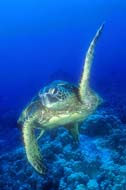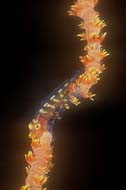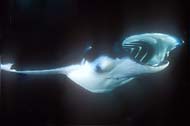Back in August, I realized I hadn’t done a dive trip this year (snorkeled with sailfish & whale sharks in Mexico and took surface shots of humpbacks in Alaska, but only one tank dive all year). So I booked a week on the Kona Aggressor–a liveaboard dive boat which operates off the Kona Coast (west side of Hawaii–the Big Island). When I told this to one of my experienced diver friends, she asked one question: "Why?" It’s not an unreasonable question from divers who travel quite a bit, as fun as a week diving in Hawaii might sound.
The reefs in Hawaii (above) are far less colorful then other locations further west. Fish, especially large schools, are not plentiful.
|

|

|
I had two main reasons for deciding to go there. First, I hoped for more photo opportunities with green sea turtles (Chelonia mydas) at a site called Turtle Pinnacle, which is a cleaning station where the turtles allow the reef fish to remove algae and parasites from their shells. Unfortunately, the turtles didn’t show up at this site during our dive there–the two shots above were taken my on last visit to the Big Island in 2003. The second reason was that a trip to Kona from my home near San Francisco represents one plane flight each way for me. This might sound like a trivial reason, but on each of my last three trips by air (coming back from Mexico and both going and coming from Juneau) my first flight was delayed and I missed my connecting flights. We all know air travel is much more of a hassle now, and minimizing Things That Could Go Wrong was a factor in my decision.
|

|

|
The photos above are of Holly Ong–my dive buddy for the week. Holly lives just south of San Francisco, and we are both members of the No. CA Underwater Photographic Society–but we didn’t know each other prior to meeting on this trip! We both have SCUBA certification cards so old (early 70’s) they don’t have individual numbers on them. She is one of those "been there, done that" divers, and an excellent buddy–always aware of where I was (versus my tendency to wander away with my face stuck in the viewfinder), and we have similar rates of air consumption. She is also very cheerful and upbeat–always an asset in the close confines of a liveaboard dive boat.
|

|

|
The photos above are two of the tiny critters we saw. The shot on the left is a Black White Spotted Crab (Lissocarcinus orbicularis) which is about the size of a dime. It lives on the Black Sea Cucumber (Holothuria atra) and does no harm to its host. The photo at right is of a Wire Coral Goby (Brianinops amplus) which is less than an inch in length. The goby tends to hide on whatever side of the wire coral you are not on, and with the coral itself moving back and forth, this is not an easy subject to photograph!
Here are a few of the reef denizens we saw. The photo at top left is of a Whitemouth Moray Eel (Gymnothorax meleagris), which is one of the most common eel species (and there are many!) in Hawaii. Top right is a Guineafowl Puffer (Arothron meleagris) which occasionally hovers in place on the reef so you can grab a photo. Various members of the Scorpaenidae family can be hard to distinguish, but (I think) the photo at bottom left is of a Titan Scorpionfish (Scorpaenopsis diabolus), which is endemic to Hawaii. At bottom right is a Leaf Scorpionfish (Taenianotus tricanthus). They come in a variety of colors, are small and hard to find. I actually found this one myself–VERY unusual, as I’m one of the worst critter spotters. Most of the smaller subjects in my photos were pointed out to me by someone else.
A dive photo trip to Hawaii wouldn’t be complete without frogfish (Antennariidae sp.) photos. These four photos are of two frogfish that were right next to each other. I think you can probably make out the frogfish in the two photos on the bottom above, but good luck with the two photos on the top if you don’t have experience seeing these guys! Well, here’s a hint–click on the photo at top left to enlarge, and find the mouth of the fish on the top right side of the photo. From about the middle of the mouth, proceed back to the left, about a third of the way and hopefully you can make out the eye. You can probably see the mouth of the fish in the photo top right (near bottom of the photo), but the angle makes finding an eye more work than its worth.
 |
 |
The Kona night dives with manta rays (Manta sp.) were an unexpected highlight. The mantas feed on the plankton attracted by lights provided by divers and the nearby airport. These dives are world-famous in the diving community and immensely popular. There were 10-12 boats and 40-50 divers present for each of the two night dives we did here. I’d declined doing them during my last trip, because I feared all the divers would be mucking up the visibility and getting between my camera and the mantas. The mantas, in feeding mode with their mouths open, come so CLOSE that it’s still possible to get good photos.
Another interesting aspect of this night dive was the appearance of these eight Oval Squid (Sepioteuthis lessoniana). Naturally this attracted a lot of attention, but I just waited until late in the dive when most of the other divers had gone back to their boats.
I then tried for some shots with both the squid and a feeding manta, but I didn’t follow the "get close" part of the photo mantra ("get low, get close, shoot up") to get a good enough angle for a decent shot. Too bad–the photo opportunity was certainly there.
Despite my apprehension about doing the manta night dive because of all the people, this shot above with the divers and manta turned out to be my favorite of the trip. You might notice none of the divers are wearing snorkels. We were prohibited from doing so, because the mantas swoop down so close a snorkel could scrape and harm them. So I learned my lesson, and pass it on to you–if you’re ever diving in Kona, DON’T neglect to do the manta night dive!
Best to all,
Ken
http://www.seaimages.org
|